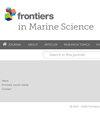夏季南海北部强陆架锋附近的沿海风动上升流引起了海温变化的天气-季节内变化
IF 3
2区 生物学
Q1 MARINE & FRESHWATER BIOLOGY
引用次数: 0
摘要
潮汐变率和沿海上升流是全球陆架海的一些最重要的过程。通过观测和高分辨率数值模拟,研究了南海北部雷州半岛和琼州海峡东部潮温变化的天气-季节内变化,并阐明了潜在的动力。结果表明,在较窄的经向带中,浅海的潮温变化最为显著(<;夏季雷州半岛和琼州海峡以东40 m),海底斜坡处有较强的热锋。夏季时温平均日标准差可达0.93℃。夏季潮温变化不存在春季—小潮周期,但有较强的季节—天气变化,逐时温度的日标准差在0 ~ 2.36℃范围内变化显著。进一步分析表明,夏季潮汐温度变化的天气-季节内变化主要是由风驱动的沿海上升流引起的。当南风较弱时,沿岸上升流较弱,导致近海热锋远离雷州半岛。近海热锋与雷州半岛/琼州海峡之间的水域混合较好,潮温变化不大。当南风强时,沿岸上升流强,导致近雷州半岛近海热锋向西移动。这与复杂的地形和潮流相结合,有利于近岸热锋的形成。潮流引起的近岸热锋摆动产生了显著的潮温变率。上述结果强调了沿海上升流/下升流对大陆架海热锋附近潮汐温度变化的重要调节作用。本文章由计算机程序翻译,如有差异,请以英文原文为准。
Wind-driven coastal upwelling causes synoptic-to-intraseasonal variations in tidal temperature variability near a strong shelf front in the northern South China Sea in summer
Tidal variability and coastal upwelling are some of the most important processes in global shelf seas. With observations and high-resolution numerical simulation, we investigate the synoptic-to-intraseasonal variations in tidal temperature variability to the east of the Leizhou Peninsula and Qiongzhou Strait in the northern South China Sea and clarify the underlying dynamics. The results indicate that tidal temperature variability is most significant in a narrow meridional band in shallow waters (< 40 m) to the east of the Leizhou Peninsula and Qiongzhou Strait in the summer when there are strong thermal fronts located on the sea floor slope. The summer mean diurnal standard deviation of hourly temperature can reach up to 0.93°C. Tidal temperature variability in summer exhibits no spring-neap cycles but strong synoptic-to-intraseasonal variations, with the diurnal standard deviation of hourly temperature varying significantly from 0°C to 2.36°C. Further analyses indicate that synoptic-to-intraseasonal variations in tidal temperature variability in the summer are predominantly caused by wind-driven coastal upwelling. When southerly winds are weak, coastal upwelling is weak and leads to the offshore thermal front being located far away from the Leizhou Peninsula. Waters between the offshore thermal front and the Leizhou Peninsula/Qiongzhou Strait are mixed well and experience insignificant tidal temperature variability. When southerly winds are strong, coastal upwelling is strong and results in the offshore thermal front moving westward close to the Leizhou Peninsula. This facilitates the formation of the nearshore thermal front in combination with the complex topography and tidal currents. Tidal current-induced swinging of the nearshore thermal front then generates significant tidal temperature variability. The above results highlight the importance of coastal upwelling/downwelling in modulating tidal temperature variability near ocean thermal fronts in the shelf seas.
求助全文
通过发布文献求助,成功后即可免费获取论文全文。
去求助
来源期刊

Frontiers in Marine Science
Agricultural and Biological Sciences-Aquatic Science
CiteScore
5.10
自引率
16.20%
发文量
2443
审稿时长
14 weeks
期刊介绍:
Frontiers in Marine Science publishes rigorously peer-reviewed research that advances our understanding of all aspects of the environment, biology, ecosystem functioning and human interactions with the oceans. Field Chief Editor Carlos M. Duarte at King Abdullah University of Science and Technology Thuwal is supported by an outstanding Editorial Board of international researchers. This multidisciplinary open-access journal is at the forefront of disseminating and communicating scientific knowledge and impactful discoveries to researchers, academics, policy makers and the public worldwide.
With the human population predicted to reach 9 billion people by 2050, it is clear that traditional land resources will not suffice to meet the demand for food or energy, required to support high-quality livelihoods. As a result, the oceans are emerging as a source of untapped assets, with new innovative industries, such as aquaculture, marine biotechnology, marine energy and deep-sea mining growing rapidly under a new era characterized by rapid growth of a blue, ocean-based economy. The sustainability of the blue economy is closely dependent on our knowledge about how to mitigate the impacts of the multiple pressures on the ocean ecosystem associated with the increased scale and diversification of industry operations in the ocean and global human pressures on the environment. Therefore, Frontiers in Marine Science particularly welcomes the communication of research outcomes addressing ocean-based solutions for the emerging challenges, including improved forecasting and observational capacities, understanding biodiversity and ecosystem problems, locally and globally, effective management strategies to maintain ocean health, and an improved capacity to sustainably derive resources from the oceans.
 求助内容:
求助内容: 应助结果提醒方式:
应助结果提醒方式:


